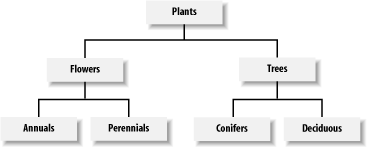WebReference.com - Part 2 of chapter 5 from Information Architecture for the World Wide Web, 2nd Edition. From O'Reilly (1/5).
[next] |
Information Architecture for the WWW, 2E. Chapter 5: Organization Systems
Organization Structures
[The following is the conclusion of our pair of excerpts from chapter 5 of the O'Reilly & Associates title, Information Architecture for the World Wide Web, 2nd Edition.]
Organization structure plays an intangible yet very important role in the design of web sites. While we interact with organization structures every day, we rarely think about them. Movies are linear in their physical structure. We experience them frame by frame from beginning to end. However, the plots themselves may be nonlinear, employing flashbacks and parallel subplots. Maps have a spatial structure. Items are placed according to physical proximity, although the most useful maps cheat, sacrificing accuracy for clarity.
The structure of information defines the primary ways in which users can navigate. Major organization structures that apply to web site and intranet architectures include the hierarchy, the database-oriented model, and hypertext. Each organization structure possesses unique strengths and weaknesses. In some cases, it makes sense to use one or the other. In many cases, it makes sense to use all three in a complementary manner.
The Hierarchy: A Top-Down Approach
The foundation of almost all good information architectures is a well-designed hierarchy or taxonomy.[1] In this hypertextual world of nets and webs, such a statement may seem blasphemous, but it's true. The mutually exclusive subdivisions and parent-child relationships of hierarchies are simple and familiar. We have organized information into hierarchies since the beginning of time. Family trees are hierarchical. Our division of life on earth into kingdoms and classes and species is hierarchical. Organization charts are usually hierarchical. We divide books into chapters into sections into paragraphs into sentences into words into letters. Hierarchy is ubiquitous in our lives and informs our understanding of the world in a profound and meaningful way. Because of this pervasiveness of hierarchy, users can easily and quickly understand web sites that use hierarchical organization models. They are able to develop a mental model of the site's structure and their location within that structure. This provides context that helps users feel comfortable. Figure 5-11 shows an example of a simple hierarchical model.

Figure 5-11: A simple hierarchical model
Because hierarchies provide a simple and familiar way to organize information, they are usually a good place to start the information architecture process. The top-down approach allows you to quickly get a handle on the scope of the web site without going through an extensive content-inventory process. You can begin identifying the major content areas and exploring possible organization schemes that will provide access to that content.
1. [Back] In recent years, the business world has fallen in love with the term "taxonomies." Many biologists and librarians are frustrated with the exploding abuse of this term. We use it specifically to refer to a hierarchical arrangement of categories within the user interface of a web site or intranet. If you can't beat them, join them.
[next] |
Created: September 30, 2002
Revised: September 30, 2002
URL: https://webreference.com/authoring/design/information/iawww/chap5/2/


 Find a programming school near you
Find a programming school near you